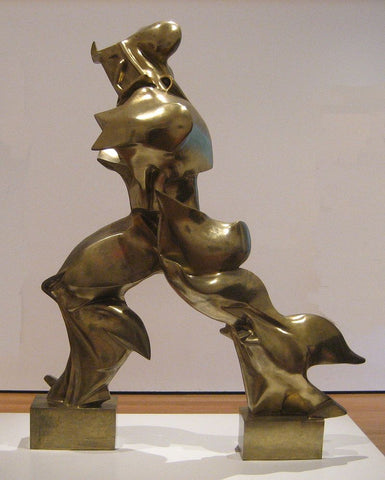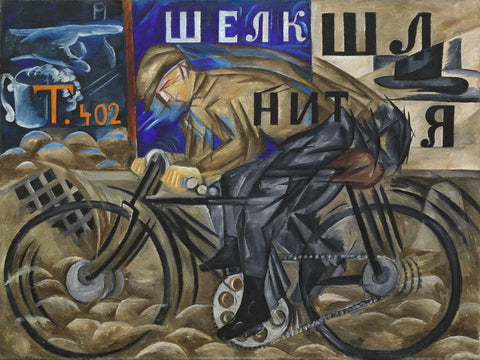What is futurism? It’s an art movement that has its roots in Italy, where it emerged at the beginning of the 20th century. The artists from this movement were well acknowledged with the latest technological inventions and fascinated with them. Their main principle was to embrace the future and leave behind the restrictive, conservative beliefs about art while celebrating technology. Do you wish to learn more? Then read on!
What Is Futurism? Definition
Let’s start with the definition of futurism. It is an avant-garde art movement that emerged in 1909 in Italy. Futuristic art is aimed at showing the dynamics of modern life, with movement, speed, change, and even violence on the first plan.
Futurism artists often utilize elements of the previous art movements, like the geometry in the art of the Cubists, to depict objects from different angles and perspectives. Yet, they don’t rely purely on borrowed techniques, as they also seek to portray the rapid movement of objects, which they do by using outlines and shades.
The History of Futurism
Futurism started in 1909 when the French newspaper Le Figaro published the manifesto of Filippo Tommaso Marinetti. In the text, he coined the term Futurism and declared that the artists in Italy want to give up on the old ways and traditions and embrace modern technology, celebrate it, and change the approach to art. Here are the key points of the manifesto:
- “We want to sing the love of danger, the habit of energy and rashness.
- The essential elements of our poetry will be courage, audacity and revolt.
- Literature has up to now magnified pensive immobility, ecstasy and slumber. We want to exalt movements of aggression, feverish sleeplessness, the double march, the perilous leap, the slap and the blow with the fist.
- We declare that the splendor of the world has been enriched by a new beauty: the beauty of speed. A racing automobile with its bonnet adorned with great tubes like serpents with explosive breath ... a roaring motor car which seems to run on machine-gun fire, is more beautiful than the Victory of Samothrace.
- We want to sing the man at the wheel, the ideal axis of which crosses the earth, itself hurled along its orbit.
- The poet must spend himself with warmth, glamour and prodigality to increase the enthusiastic fervor of the primordial elements.
- Beauty exists only in struggle. There is no masterpiece that has not an aggressive character. Poetry must be a violent assault on the forces of the unknown, to force them to bow before man.
- We are on the extreme promontory of the centuries! What is the use of looking behind at the moment when we must open the mysterious shutters of the impossible? Time and Space died yesterday. We are already living in the absolute, since we have already created eternal, omnipresent speed.
- We want to glorify war - the only cure for the world - militarism, patriotism, the destructive gesture of the anarchists, the beautiful ideas which kill, and contempt for woman.
- We want to demolish museums and libraries, fight morality, feminism and all opportunist and utilitarian cowardice.
- We will sing of the great crowds agitated by work, pleasure and revolt; the multi-colored and polyphonic surf of revolutions in modern capitals: the nocturnal vibration of the arsenals and the workshops beneath their violent electric moons: the gluttonous railway stations devouring smoking serpents; factories suspended from the clouds by the thread of their smoke; bridges with the leap of gymnasts flung across the diabolic cutlery of sunny rivers: adventurous steamers sniffing the horizon; great-breasted locomotives, puffing on the rails like enormous steel horses with long tubes for bridle, and the gliding flight of aeroplanes whose propeller sounds like the flapping of a flag and the applause of enthusiastic crowds.” (via Society for Asian Art)
This inspired many Italian artists, especially those in Milan, including painters, sculptors, poets, and composers. As a result, they started to create art in accordance with the points mentioned in the manifesto and even attempted to create their own guides since Marinetti did not lay any artistic program out.
At more-or-less the same time, the Russians started embracing their own Futurism and also focused on the dynamics and technology. The main difference was that they had a different approach towards the whole political and social ideology of the Italian futurist. They even rejected Marinetti as he was frowned upon due to his commitment to fascism.
No matter whether it was Italy, Russia, or any other country (since the movement did spread, but it wasn’t as popular across the world as in these two countries), it slowly came into decline in the second half of the 1910s and was rejected after the World War I, when people began to perceive technology as a means to destruction.
Nevertheless, Futurism was an important element of the history of modern art, as it inspired many architects in the 1920s and was the first of the movements that attempted to break off from the traditional restrictions imposed on artists.
Examples of Futurism Art and Most Famous Artist
Having discussed the history of Futurism in art, let’s focus on the most well-known representatives of both the Italian and the Russian movements. Who are they, and what works did they create?
Filippo Tommaso Marinetti (1876-1944) – As the founding father of Futurism in Italy, he created numerous pieces of art that…weren’t really successful. Therefore, his Futurist Manifesto remains his most famous work.Umberto Boccioni (1882-1916) – Bocconi is one of the key figures in Italian Futurism and is mostly recognized for his sculptures. The most iconic one is titled Unique Forms of Continuity in Space and is currently owned by the Museum of Modern Art in New York.

Natalia Goncharova (1881-1962) – Goncharova has contributed to numerous modern art movements, including Russian Futurism. Her most famous work is titled Cyclist and is an excellent depiction of the importance of movement in Futurism art.

Carlo Carrà (1881-1966) – Carrà was a crucial member of the movement. His art combined elements of Futurism with real events, capturing the atmosphere of the time. One of his most important works is The Funeral of the Anarchist Galli which is an excellent example of the impact of nationalism and even fascism on the movement.
The Takeaway
Knowing what Futurism is in art, you probably realize how critical it was in the journey that art has embarked on in the 20th and 21th centuries. The break off from tradition and embracing movement has helped many other movements, like street art, emerge, so we mustn’t forget how much we owe to Futurism.
You may also read about the 5 Best Online Art Galleries.
Sources:
https://www.societyforasianart.org/sites/default/files/manifesto_futurista.pdf
